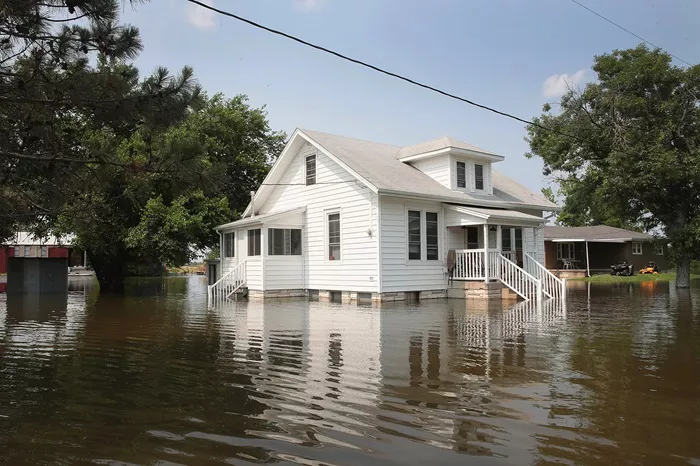When considering the safety and protection of personal property, renters often overlook flood insurance, assuming it to be unnecessary or irrelevant. However, the increasing frequency of severe weather events and the unpredictable nature of natural disasters make flood insurance a critical consideration for renters, particularly those living in flood-prone areas. This article delves into the necessity of flood insurance for renters, the limitations of standard renters insurance, the specifics of flood insurance coverage, costs, purchasing options, risk assessment, landlord insurance implications, types of coverage, and policy details.
Necessity of Flood Insurance for Renters
Flood insurance is not typically mandated for renters by law or by most landlords. However, it is highly recommended, especially for those residing in areas prone to flooding. These areas can include regions near rivers, coastal zones, and low-lying regions susceptible to heavy rainfall or hurricanes. Even if flood risk appears minimal, the unpredictability of climate events means that no area is entirely safe from the potential of flooding.
While some renters may assume that their personal property is protected under their landlord’s insurance or a standard renters insurance policy, this is a misconception. Landlord insurance generally covers the building structure but not the personal belongings of tenants. Thus, flood insurance becomes a crucial safeguard against potential financial loss due to water damage.
Standard Renters Insurance Limitations
Most standard renters insurance policies do not cover damage caused by flooding. These policies typically provide protection against incidents like fire, theft, and certain types of water damage (such as from a burst pipe), but explicitly exclude flood-related damage. This significant gap in coverage means that in the event of a flood, renters without a separate flood insurance policy would be left to bear the full financial brunt of replacing damaged items and repairing any damage.
This limitation is why obtaining a dedicated flood insurance policy is essential for those who wish to fully protect their belongings and have peace of mind. Without it, the financial impact of flood damage can be devastating, potentially costing thousands of dollars in replacements and repairs.
Coverage Details
Renters flood insurance is designed to cover personal belongings that could be damaged in a flood. The coverage typically includes:
Furniture: Items such as sofas, tables, chairs, and beds.
Clothing: All types of garments, from everyday wear to special occasion outfits.
Electronics: Devices like televisions, computers, and gaming consoles.
Appliances: Small kitchen and household appliances.
Personal Items: Books, art, jewelry, and other personal property.
Each policy will have specific limits, meaning there is a cap on the amount of coverage available for different categories of belongings. Renters need to understand these limits and ensure they are sufficient to cover their most valuable possessions.
see also: What Is The Best Type Of Cat Insurance
Cost of Flood Insurance
The cost of flood insurance for renters can vary depending on several factors, including the location of the rental property, the amount of coverage selected, and the risk level of the area. However, flood insurance is generally quite affordable. On average, renters can expect to pay between $100 and $300 per year for flood insurance. This is a relatively small price to pay for the protection and peace of mind it provides, especially when considering the potential cost of replacing personal belongings after a flood.
In flood-prone areas, the cost may be higher due to the increased risk, but even then, the expense is often justified by the level of protection offered. Renters should compare rates and coverage options to find a policy that meets their needs and budget.
How to Purchase
Renters can purchase flood insurance through the National Flood Insurance Program (NFIP) or through private insurance companies. The NFIP, managed by the Federal Emergency Management Agency (FEMA), offers flood insurance to property owners, including renters, in participating communities.
Steps to Purchase Flood Insurance
Evaluate Your Needs: Determine the amount of coverage you need based on the value of your personal property.
Contact an Insurance Agent: Speak with an insurance agent who is knowledgeable about flood insurance options. The NFIP website provides a list of agents who can sell their policies.
Compare Policies: Look at policies offered by both the NFIP and private insurers. Compare coverage options, limits, deductibles, and premiums.
Select a Policy: Choose a policy that best suits your needs and budget.
Complete the Application: Fill out the necessary paperwork with your insurance agent.
Payment: Pay the premium to activate the policy.
It’s important to note that there is typically a 30-day waiting period from the date of purchase before the flood insurance policy becomes effective, so renters should not wait until a flood threat is imminent to buy coverage.
Risk Assessment
Renters should assess their flood risk to make an informed decision about purchasing flood insurance. This can be done by looking up their address on FEMA’s flood zone maps, which categorize areas based on their level of flood risk.
Steps to Assess Flood Risk
Visit FEMA’s Flood Map Service Center: Access the maps at FEMA’s website.
Enter Your Address: Input your rental property address to see its flood zone classification.
Review the Map: Understand the flood zone designation
Zone A or AE: High risk, mandatory for properties with federally backed mortgages.
Zone X: Moderate to low risk.
Zone V: Coastal high risk.
Knowing the flood zone classification helps renters understand their risk level and the necessity of purchasing flood insurance.
Landlord’s Insurance
Landlords typically have insurance that covers the building structure itself but not the tenant’s personal property. This means that in the event of a flood, while the physical building might be repaired or rebuilt under the landlord’s insurance policy, the renter’s belongings would not be covered.
Therefore, relying on the landlord’s insurance is not an option for renters looking to protect their possessions. Renters need their own insurance policy to cover their personal items, emphasizing the importance of having a dedicated flood insurance policy.
Actual Cash Value vs. Replacement Cost
When selecting flood insurance, renters will encounter two primary types of coverage: actual cash value and replacement cost.
Actual Cash Value (ACV)
- Covers the cost to replace items minus depreciation.
- If a five-year-old television is damaged in a flood, the insurance would pay out the value of a five-year-old TV, not the cost to buy a new one.
Replacement Cost Coverage (RCC)
- Covers the cost to replace items at their current market value.
- This means if a television is damaged, the insurance would cover the cost to buy a new one of the same make and model.
Choosing the Right Coverage
- Budget Consideration: ACV policies generally have lower premiums but may leave renters with higher out-of-pocket costs after a claim.
- Protection Level: RCC policies are more expensive but offer better financial protection by covering the full cost of replacing items.
Renters should carefully consider their financial situation and risk tolerance when choosing between ACV and RCC.
see also: The Best Type Of Dog Insurance
Policy Limits and Deductibles
Flood insurance policies have specific limits and deductibles that affect how much coverage is provided and what out-of-pocket costs a renter may incur.
Policy Limits
- The maximum amount an insurance company will pay out for a covered loss.
- Renters should ensure the policy limits are sufficient to cover the full value of their belongings.
Deductibles
The amount the policyholder must pay out of pocket before the insurance kicks in.
Higher deductibles typically result in lower premiums, but higher out-of-pocket costs in the event of a claim.
Example
- A policy with a $1,000 deductible means the renter would pay the first $1,000 of any claim. If the total damage is $10,000, the insurance would cover $9,000 after the deductible is met.
- Choosing the right balance between policy limits and deductibles is crucial for ensuring adequate protection without excessive cost.
Additional Living Expenses
It is important for renters to note that most flood insurance policies do not cover additional living expenses (ALE). ALE includes costs incurred if the rental property becomes uninhabitable due to flooding, such as hotel stays, meals, and other extra living expenses.
Since ALE is not typically covered by flood insurance, renters need to have a plan for how they will manage these costs in the event they need to temporarily relocate. Some renters may opt to save an emergency fund or look for supplementary insurance that provides ALE coverage.
Conclusion
Flood insurance for renters, while not mandatory, is a highly recommended safeguard against the financial devastation caused by flooding. Given the limitations of standard renters insurance policies, having a separate flood insurance policy ensures that personal belongings are protected. Understanding the coverage details, costs, purchasing options, and the implications of landlord’s insurance, as well as assessing the risk and understanding the difference between actual cash value and replacement cost coverage, allows renters to make informed decisions.
Ultimately, flood insurance provides peace of mind, knowing that in the
FAQs about Renters Insurance in Florida
1. Do renters in Florida need flood insurance?
While renters in Florida are not legally required to have flood insurance, it is highly recommended, especially given the state’s vulnerability to hurricanes and flooding. Standard renters insurance policies typically do not cover flood damage, so obtaining a separate flood insurance policy can protect your personal belongings from water damage caused by floods.
2. How much is USAA renters insurance?
The cost of USAA renters insurance varies based on several factors, including the location of the rental property, the amount of coverage needed, and any additional riders or endorsements. On average, USAA renters insurance can cost between $10 and $25 per month. It’s best to get a personalized quote from USAA to understand the exact cost based on your specific circumstances.
3. How much is renters’ flood insurance in Florida?
The cost of renters’ flood insurance in Florida can vary significantly based on the property’s location, flood risk, and the amount of coverage required. On average, renters’ flood insurance can range from $100 to $300 per year. For properties in high-risk flood zones, the cost may be higher. It’s advisable to get quotes from multiple insurers to find the best rate and coverage for your needs.
4. Is it illegal to not have renters insurance in Florida?
No, it is not illegal to not have renters insurance in Florida. However, many landlords require tenants to carry renters insurance as a condition of their lease. Renters insurance provides valuable protection for personal belongings and liability, so even if it’s not mandated by law or your landlord, it is a wise investment to safeguard against potential losses.
You Might Be Interested In



















